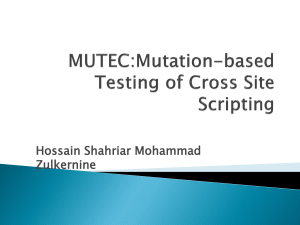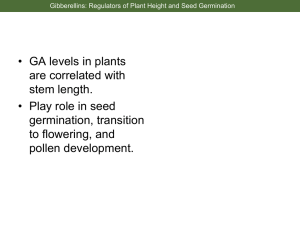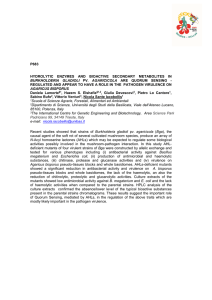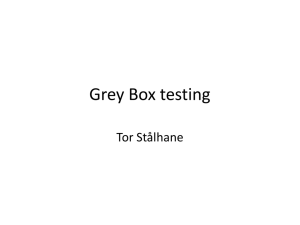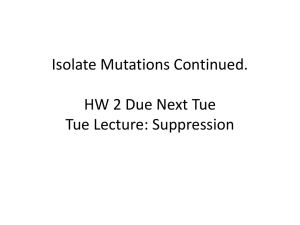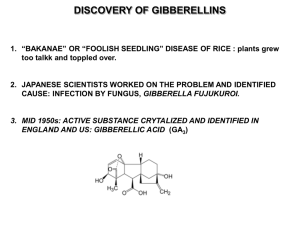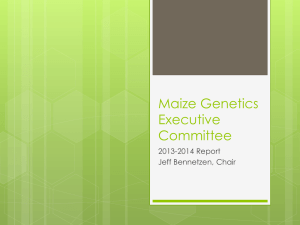Forward Genetics
advertisement
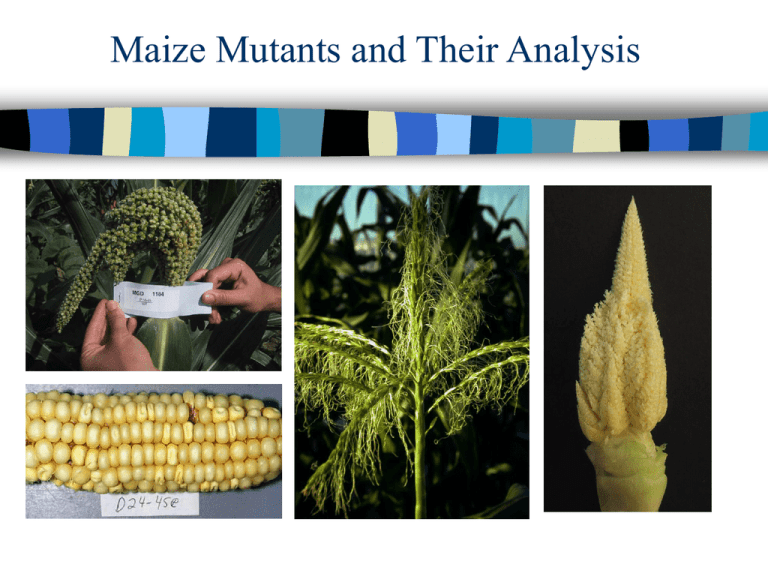
Maize Mutants and Their Analysis Generating Mutants; Forward Genetics 1. Generating your own mutants – EMS – Gamma/X-rays – Transposon Tagging 2. Public Collections of Mutants – Databases of EMS-generated mutants – Databases of (likely) transposon-induced mutants – The collection at Maize Genetics Cooperation Stock Center EMS Mutagenesis For creating a broad spectrum of new mutants For creating new alleles of an existing mutant For identifying suppressors and enhancers of a particular mutant phenotype EMS Mutagenesis of Pollen Paraffin oil pollen treatment with EMS-- M.G. Neuffer-”Mutagenesis” in The Maize Handbook (M. Freeling and V. Walbot, eds) 1993 Treated pollen is applied to silks F1 (M1) seed is heterozygous for EMS-generated mutations Plant M1 seed, self each plant, collect and store M2 seed Plant 20-30 seeds from each M2, observe mutants segregating A population of 3,000-5,000 M2 families should yield multiple mutants for every locus (successful treatments yield frequencies exceeding 1 recessive mutant per locus per 1000 M2 families analyzed). EMS Mutagenesis of ramosa1 ra1 is a mutation that strongly affects tassel and ear architecture Two main purposes for EMS mutagenesis of ra1: 1. To find intragenic mutations in the RA1 locus (new alleles) 2. To find new loci involved in the RA1 pathway ENHANCER/SUPPRESSOR SCREENING ON A WEAK ra1 ALLELE (ra1-RS) ra1 weak phenotype ra1-RS allele is due to a 2bp insertion at the very beginning of the coding sequence and encodes for a slightly shorter protein ra1-RS 2bp insertion 0 9 aa 0 166 aa Erik Vollbrecht (unpublished) EMS MUTAGENESIS AND SCREENING ra1 weak EMS treated pollen ra1 weak M0 M1 M2 families ~ 1100 M2 families screened so far for enhanced/suppressed phenotypes (not a complete genome coverage) Identified 16 families segregating new mutations affecting branching: 10 show an enhanced branched ear phenotype but no obvious change in tassel phenotype 2 show an enhanced branched ear and tassel phenotype 3 show a suppressed branched tassel phenotype 1 shows an enhanced tassel phenotype, but no effect on ear M2 FAMILIES SEGREGATING FOR ENHANCED EAR BRANCHING Branched ear phenotypes 00F20-120 00F20-247 00F20-284 00F20-318 M2 FAMILIESSEGREGATING FOR ENHANCED EAR AND TASSEL BRANCHING Enhanced branched tassel and ear phenotypes 00F20-139 •Are the mutations intragenic or extragenic? •Can sequence the ra1 locus and look for new mutations 00F20-392 SEQUENCING OF THE RA1 LOCUS FROM NEW MUTANTS ra1-RS 00F20-120 2bp insertion RA 21 -2,9 kb • • -1 kb RA 1 RA 44 0 RA 50 RA 13 176 aa Sequenced ra1 gene from DNA of segregating mutant plants in M2 families Have sequenced ra1 for 12 out of the 16 families Results •Found one new allele of ra1! 00F 20-120 family has a point mutation in ra1 locus in the coding sequence causing a missense mutation (a G-C transvertion) resulting in an amino acid change from Leu/Phe at position 160) The mutation resides in a known repression domain The mutation seems to affect ear branching only; no significant enhancement in tassel branching phenotype! 00F20-120 What was obtained from the EMS mutagenesis of ra1-RS? Potentially, several new loci involved in the branching pathways have been identified; more are likely to be identified with continued screening. One new interesting allele of ra1. •Now the hard work begins 1. Are they allelic to each other? Complementation tests 2. Do the enhancers increase branching in standard maize inbreds? Back cross to different inbred lines. 3. Are these suppressors/enhancers known loci affecting branching? Mapping and QTL 4. What is the developmental defect in the enhanced families? Careful phenotypic analysis by SEM of immature ear and tassel Generating Mutants; Forward Genetics 1. Generating your own mutants – EMS – Gamma/X-rays – Transposon Tagging Gamma/X-rays for Mosaic and Clonal Analysis Means of determining whether a gene acts in a cell autonomous or non-autonomous manner. To study the relationship of cell lineages during development of the plant. An example from a study of the control of leaf epidermal cell morphology. Frank, MJ et al. 2003 Development 130:753-762 Hake and Sinha1994 in The Maize Handbook PLANT brk1 CLONAL SECTOR + brk1 gamm a lw2 + brk2 vp5 + irradiation lw2 brk2 vp5 gamm a irradiation brk3 Oy700 + + brk3 gamm a irradiation Oy700 LEAF Generating Mutants; Forward Genetics 1. Generating your own mutants – EMS – X-rays – Directed Transposon Tagging Directed Transposon Tagging A classic and (still current) means of gene cloning in maize! SPM, AC and Mutator all proven sources for transposon tagging. Mutator has higher mutation frequency than AC or SPM, so often easier to find Mutator-induced mutations, but high copy number often complicates identifying and cloning tagged gene. AC and SPM-tagged alleles are often easier to clone due to lower copy number in genome. Lets look at an example of transposon tagging with Mutator. Directed Transposon Tagging An example---cloning the male sterile silky1 (si1) gene using Mutator. si1 y1/si1 y1 X Si1 Y1/Si1 Y1, Mu-active (white seed/silky tassel) X (Yellow seed/normal tassel) all Yellow seed (y1/Y1) si1 y1/Si1 Y1 (99.99%) Normal Phenotype si1 y1/si1-mum Y1 (rare mutant 1/10000) X Si1 y1/Si1 y1 Yellow seed have tagged si1 allele (Si1 y1/si1-mum Y1) Grow plants from yellow seed and backcross to si1 y1/si1 y1. Plant out seeds, score for silky vs normal tassel phenotype. Prepare DNA from leaves of each type. •Perform co-segregation analysis to identify transposon linked to your mutant phenotype. Southern Blot Hybridized with Mu1 Probe (normal tassel) (silky tassel (si1/si1-mum)) Generating Mutants; Forward Genetics 1. Generating your own mutants – EMS – Gamma/X-rays – Transposon Tagging 2. Public Collections of Mutants – Databases of EMS-generated mutants – Databases of (likely) transposon-induced mutants – The collection at MGSC Public Collections of Mutants Maize GDB (http://www.maizegdb.org/) (http://www.maizegdb.org/phenotype.php) Has a vast collection of mutants and associated alleles, linked to references containing background information about locus. Maize Inflorescence Architecture Project (http://www.maizegdb.org/ems-phenotype.php) A new project primarily cataloging EMS-generated inflorescence (ear and tassel) mutants but also documenting other adult and seedling mutant phenotypes. •Generated in defined inbred backgrounds (B73 and A619) and B73/Mo17 hybrid. Shooting for 3000-5000 M2 families. Public Collections of Mutants Databases of (likely) transposon-induced mutants Maize Gene Discovery Project (RescueMu Phenotype Data In MaizeGDB) (http://www.maizegdb.org/rescuemu-phenotype.php) A database of over 31,000 mutants from screens of RescueMu-containing/Mutator lines. Includes seed, seedling, and various stages of adult phenotypes. F2 seeds for any phenotype can be ordered from MGCSC. Functional Genomics of Maize Endosperm (http://www.endosperm.org/) A database of seed mutants from Mutator-containing lines in a W22 inbred background. All mutants are in a Mu-off state. Order seed through web address. Photosynthetic Mutant Library (PML)(http://pml.uoregon.edu) – Phenotype data of Mu-induced, non-photosynthetic maize mutants. Public Collections of Mutants The collection at the Maize Genetics Cooperation Stock Center(http://w3.aces.uiuc.edu/maize-coop/) A fantastic catalog of well maintained stocks of maize mutants of all types, some dating back to the early 1900s. The source for reference alleles. Linkage groups often available (eg. o2 gl1 v5 ra1 on 7S) Repository for mutant stocks from many genome projects, including EMS mutants from the Maize Inflorescence Architecture Project and Maize Gene Discovery Project. Seed requests can be made on line, and orders are filled within a couple of days!! Maize Mutants and Their Analysis
